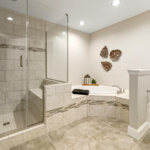Water damage is one of the most common and costly problems homeowners face, and it can happen unexpectedly. In places like Romeoville, where weather patterns can be unpredictable, taking the right precautions is essential to avoid potential disasters.
This article will guide you through the necessary steps to protect your home from needing water damage restoration. Each section focuses on a different part of your home, helping you take a comprehensive approach to keeping your property safe.
1. Inspect And Maintain Your Roof
Your roof is your home’s first line of defense against water, making it a critical area to maintain. Even a small leak in the roof can lead to big problems over time, such as water entering your attic, soaking insulation, and eventually affecting your walls and ceilings.
Start by checking your roof for any signs of damage. This includes loose or missing shingles, cracked tiles, or areas where the roofing material has started to lift. Regular inspections are key, especially after heavy storms or windy days. A professional roofing contractor can help if you notice anything concerning, but many small issues can be spotted from the ground with a good pair of binoculars.
2. Clean And Repair Your Gutters
Gutters play a crucial role in diverting water away from your home’s foundation. However, if they become clogged with leaves, dirt, and debris, they can overflow and direct water where it does not belong. This can lead to erosion, basement flooding, and foundation damage.
To keep your gutters working effectively, it is important to clean them at least twice a year—once in the fall and again in the spring. If you have a lot of trees around your home, you may need to clean them more frequently. If you’re unsure about the state of your gutters or want a professional touch, contacting a Romeoville gutter company can be a smart move. They can inspect your gutters for any necessary repairs or replacements to ensure your home stays safe from water damage.
3. Seal Windows And Doors
Windows and doors are common entry points for water, especially if they are not properly sealed. Over time, weatherstripping and caulking can wear down, creating gaps that allow water to enter your home. This can lead to rotting wood, peeling paint, and, eventually, mold growth.
To prevent this, inspect the seals around your windows and doors regularly. If you notice any cracks or gaps, apply fresh caulking or replace old weatherstripping to create a watertight seal. Even a small gap can let in enough water to cause damage over time, so it’s important to address these issues quickly.
Moreover, check your doors and windows after severe weather. Strong winds and heavy rain can weaken seals, so maintaining them ensures your home remains protected from the elements.
4. Slope Your Yard Away From The House
If the ground around your home slopes toward the foundation, rainwater will naturally flow toward your house, which can result in basement flooding and foundation issues. Water that pools around your home’s foundation can cause cracks and lead to costly structural damage.
Regrading your yard to create a slope that directs water away from your home is an effective way to avoid this problem. Even a slight slope can make a big difference in keeping water from collecting around your foundation.
5. Install A Sump Pump In Your Basement
Basements are particularly vulnerable to water damage, especially in areas that experience heavy rainfall. A sump pump is an essential piece of equipment for keeping your basement dry. It automatically pumps out water that collects in a sump basin.
Installing a sump pump in your basement can protect your home from unexpected water damage, especially during heavy storms. Make sure to test your sump pump regularly to ensure it is working properly. Consider investing in a battery backup system, so the pump will continue to function even if there is a power outage during a storm.
6. Use Water-Resistant Building Materials
In regions that experience frequent rainfall or flooding, using water-resistant building materials can help protect your home from potential water damage. These materials, such as treated wood, waterproof paint, and moisture-resistant drywall, are specifically designed to withstand exposure to moisture, minimizing long-term damage.
If you are renovating your home or building from scratch, consider using these types of materials in areas that are particularly vulnerable to water, such as basements, bathrooms, or laundry rooms. Even in homes that are not in flood-prone areas, incorporating water-resistant materials can help reduce the impact of leaks or humidity.
7. Keep An Eye On Plumbing Leaks
Plumbing leaks are one of the most common causes of water damage in homes, often going unnoticed until they have caused significant harm. Leaky pipes, faucets, or appliances can silently damage walls, ceilings, and floors over time, leading to costly repairs. Staying vigilant and addressing small leaks quickly is key to avoiding long-term damage.
You should routinely inspect areas where plumbing is installed, such as under sinks, around toilets, and near water heaters. Look for signs of water stains, mold growth, or unusual puddles. Fixing even minor leaks can prevent a much larger issue down the road.
If you notice a sudden spike in your water bill, it could be an indication of a hidden leak somewhere in your home. In such cases, it is wise to call a plumber for a thorough inspection and repair to stop further damage.
Protecting your home from water damage requires consistent effort and attention to detail. By taking preventive measures, you can significantly reduce the risk of costly damage. Incorporating water-resistant materials and keeping a watchful eye on potential issues can save you from future headaches. Prioritizing these tasks will ensure that your home stays safe from water damage year-round, providing peace of mind for you and your family.







